It is that time of year over here, where even if spring isn’t quite here, we do feel terribly optimistic. The days are getting longer and time pottering about in the garden is always time well spent. There is a sense of anticipation in the air as we are thinking about our vegetable garden and what needs to planted as the season changes.

Earlier this year we received the most exciting package from My Eco-Sprout… it contained starter kits for miniature pumpkin seeds and red bush beans.

Excitement was high, as a lockdown vegetable gardening family we were ready for some inspiration and thrilled to try something new. The kids were eager to use the growing seedlings as their science observation project… so a winning situation. Turns out we aren’t the very best farmers, and I will put that down to our novice status, but the kit directions were really easy to follow and My Eco-Sprout promised support and they were indeed the best support, always just one message away from helping us. So a fun project from start to finish and loads and loads of little plant varieties on their website that we would still like to try… from Mouse Melons to African Horned Cucumbers… they have it all. Take a look at all the different seeds that they have on offer.
Seeds and Seedlings
We immediately got to planting our seeds… And we decided to try them in any and all containers that we could find, especially containers that we could plant our seedlings in, once they had begun to grow.

Egg shells turned out to be an absolute winner for our beans…

It didn’t take very long for our seeds to sprout…
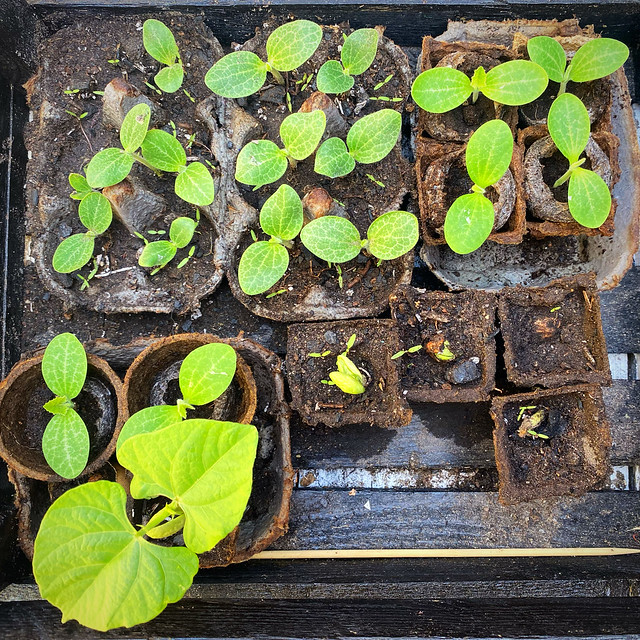
Our little farm was measured and their growth documented…

Our little farm quickly became a miniature forest…

And they were ready to plant out into the garden…

Beds and Bedding
Suddenly, we had a real use for all that compost that we have been creating… a long term goal of ours was to drastically reduce our waste and so we have been collecting our kitchen scraps and layering them up with garden cuttings into a compost heap for the longest time.

We filled up our vagi-beds with our compost… You can still see bits of egg shell in our compost, but most vegetable scraps magically broke down into soil.

And we planted our little seedlings in a sunny spot.

They didn’t flourish at first, but that was possibly because the season was changing it was cooler… so we bundled them up in a bed of straw…

And then next thing we knew we had buds…
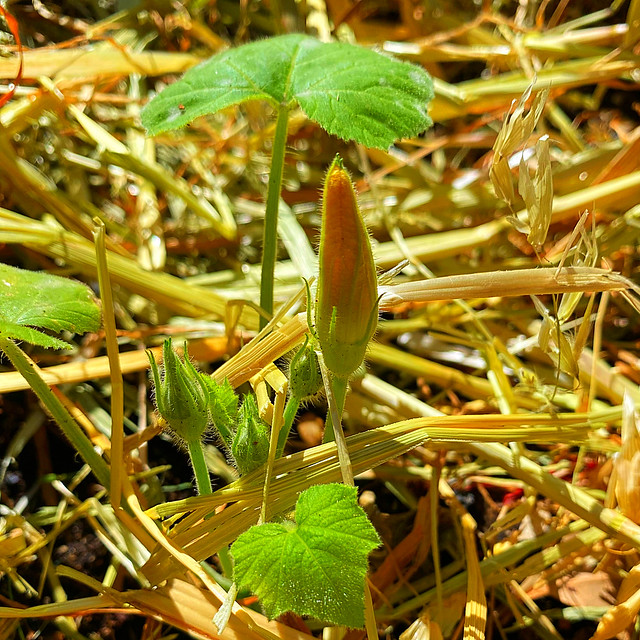
And they quickly became beautiful flowers…

Which magically became the smallest little pumpkins you ever did see…

I mean… how cute.
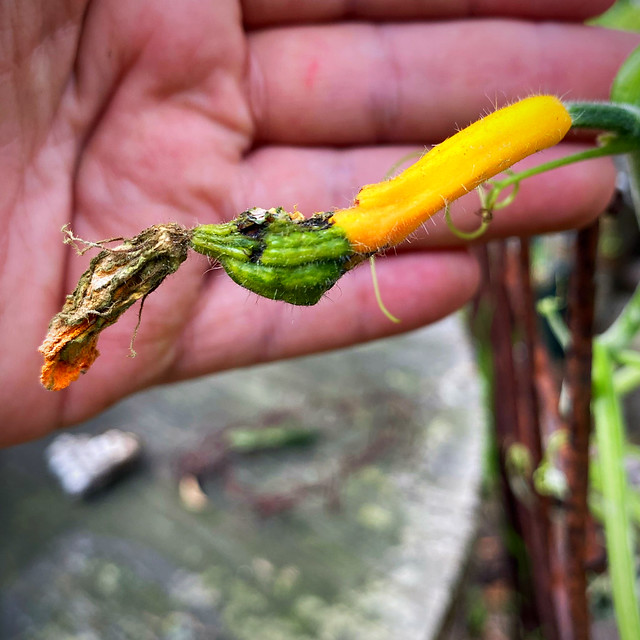
Not to mention our rabbit may have had a little feast in our pumkin patch and enjoyed our farm fresh produce!!!

And the beans… how beautiful!!!

If you are looking for seeds to plant in your garden right now, radishes are fast growing and brilliant for making observations. Also, our peas are climbing up their trellis at an unbelievable rate.
Watch How Your Garden Grows

It is very easy to turn a planting project into a science observation project… get a dedicated notebook and just start…
- Keep a diary of your seeds’ growth. Draw your plants as accurately as you can every single day. A careful look at the seedlings every day and those incremental changes quickly add up to a memorable science project.
- We had a good look at the seeds before we planted them… the bean seeds had interesting speckles, while the pumpkin seeds had a really dull colour.
- We read that the first green leaves are actually the cotyledons that protected your seed, the true leaves come a little later and they have wonderful vein patterns. Once we had a couple of leaves we were able to press leaves… the leaves of a pumpkin plant are very different to the leaves of a bean plant. You can also do leaf rubbings or leaf prints with them.
- Measure your plant’s growth every day, you will notice that plants like children have growth spurts.
- Draw your flowers and colour them… don’t be afraid to add a watercolours to your science notebook.
- We forfeited one or two of our plants to examine it more closely, if you don’t have a microscope then a magnifying glass will do… look at those little roots: Can you see the different types of roots, primary roots, secondary roots, tap roots, root hairs? Dissect bits and pieces… if you slice through the stem, what do you see… and so on…
- If you cover one of the leaves on your plant with tin foil and leave it for a couple of days (like a week!!!) See what happens? The sun doesn’t reach that part of the plant and your leaf will lose its green colouring and become pale yellow, because without sunlight your leaves cannot photosynthesise and retain their green chlorophyll.


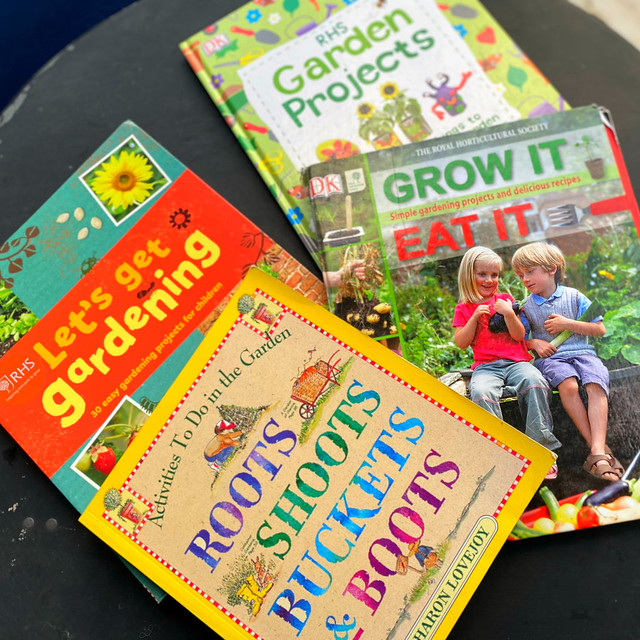
Brilliant Books for Garden Inspiration
Next, we got some books out to inspire us and help us with our investigations… while plants grow slowly there are some amazing gardening books out for children to inspire young green fingers.

- Roots, Shoots, Buckets and Boots: Is one of my all time favourite and inspirational books for nature loving kids, and their adults. It is quite the most beautiful and inspiring book, absolutely packed with ideas and things to do in the garden, and beautifully illustrated with watercolours and inks all the way through. Anyone who loves gardening will absolutely love this book. One of our favourite podcasts, 1000 hours Outdoors published an interview with the author, Sharon Lovejoy, and you can listen to the interview here.
- Let’s Get Gardening: This is a fabulous gardening book for kids, filled with at least thirty projects for young gardeners. Edible projects, wildlife projects, and even recycling ideas. I especially like the dedicated double spreads on how to plant and grow specific vegetables… tips and tricks for any vegetable gardener. It is a DK book so filled with beautiful photographs and clear explanations for kids to enjoy.
- Garden Projects: This book is a wonderfully inspiring book for young gardeners… not just planting projects but all sorts of useful and creative crafty projects too.
- Grow it, Eat it: I don’t know about you but pottering in the garden is one of my favourite things to do and something I would love to pass on to my children… well add food and recipes into the mix and my children are there for it… all of it. For each fruit or vegetable presented in this book there is an associated recipe… what a stunning idea, gardening with a tasty end goal… and for kids who love the kitchen it is great inspiration for them to step out into the garden.
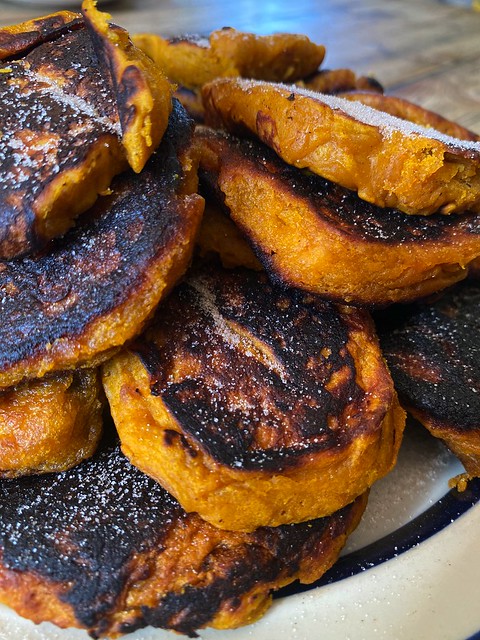
A Fabulous Feast to Celebrate Our Pumpkins
And of course, despite our pumpkins being on the extremely tiny side. We were given a giant pumpkin to feast on and we added some pumpkin fritters to our learning adventure…

Let’s Meet the Players:
- 500ml of cooked and mashed pumpkin
- 375ml of cake flour
- 45ml baking powder
- 2 eggs
- A pinch of salt
- Cinnamon Sugar to Dust
Let’s Play the Game:

- Mix all the ingredients in a large mixing bowl.
- Heat your pan with a tablespoon of oil and then fry spoonfuls of the mixture in the pan.
- Put your cinnamon sugar in a flat plate ready for your cooked fritters.
- As you take your fritters out of the pan pop them into the cinnamon sugar until they are lightly covered.

Amazon Affiliate Links for books used in this post.




Huge thank you to My Eco Sprout for the gift of seeds, that sparked our Pumpkin Adventure. This is not a sponsored post and opinions expressed are, as usual, entirely our own.
